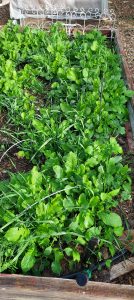Tomatoes, peppers, and zucchinis are harvested. Cold weather has descended. So, just like pulling out the electric blanket, I want to “tuck in” my garden beds with cover crops.
There are several advantages to planting cover crops. They protect soil from rains that leach out nutrients, prevent erosion, and build up soil with nitrogen and bio-mass that previous crops consumed during their growing season.
Cover crops can be:
- Legumes, like Australian peas, hairy vetch, and clovers that put nitrogen back into the soil and boost soil health.
- Hardy grains like barley, oats and rye that provide a quick cover, prevent weed growth, control erosion and create bio-mass to return to compost. Barley and oats can germinate in soil temperatures as low as 38°F.
- Brassicas like daikon radish that push their roots deeper into soil to break up and aerate it. Deep rooted cover crops improve soil structure, water absorption and nutrient-holding capacity as well as bring up nutrients from farther down in the soil to be available for other plants to use.
- Mustards and daikon radish that have natural biofumigation properties to provide pest management.
A fall cover crop consisting of a winter-hardy seed mix combination gives me some of all-of-the-above benefits. I planted by hand broad-casting into a raked bed, then lightly covered the seed and patted it down. These plants are now about 8 inches tall. They’ll hibernate during winter and resume growth in spring when they’ll be cut back, having cared for and improved the soil.
Spring-planted cover crops offer the same opportunity to ready your gardens, protecting and replenishing soils, and providing a nice break through the bare season with healthy, green plant growth. Fall and spring rains make this growing project nearly hand’s off; a big relief from the high maintenance of growing, watering and harvesting summer crops!
Allow 30-60 days of growth after germination. (For fall plantings, frost halts plant growth until the soil warms up, so there’s a longer growing period.) It’s best not to let plants go to seed before “terminating” them so as to prevent “weeds” (simply, plants you don’t want) coming up in your vegetables. Also watch some of the grasses and clovers. If left too long they can generate a root mass that makes turning under more difficult.
At the end of cover crop time, there are two ways to clear the plants; cut down or till under.
- No-till methods protect microorganisms working under the soil surface and help beneficial fungi and bacteria. Cutting down can be done with a weed whacker, hand pruner, mower, or scythe. (Watch out for your drip tubing!)
- Tilling plants under will create green manure. If using this technique, till plants under 2 to 4 weeks before planting to allow time for greens to decompose before planting new crops.
Growing cover crops offers a low-maintenance and economical way to reduce soil erosion, prevent weeds, boost soil health and create a green, attractive option for your once-bare beds. What’s not to like?
Nancy Bliss is a University of California Cooperative Extension Master Gardener of Tuolumne County.

